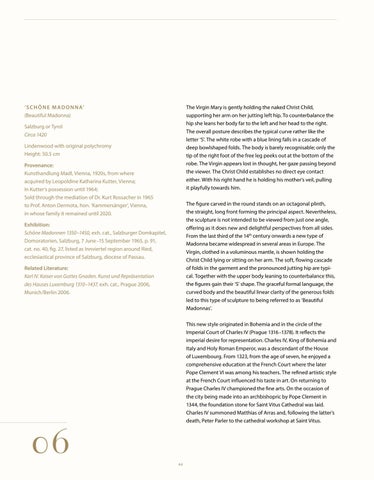‘ S C H Ö N E M A D O N N A’ (Beautiful Madonna)
The Virgin Mary is gently holding the naked Christ Child, supporting her arm on her jutting left hip. To counterbalance the hip she leans her body far to the left and her head to the right. The overall posture describes the typical curve rather like the letter ‘S’. The white robe with a blue lining falls in a cascade of deep bowlshaped folds. The body is barely recognisable; only the tip of the right foot of the free leg peeks out at the bottom of the robe. The Virgin appears lost in thought, her gaze passing beyond the viewer. The Christ Child establishes no direct eye contact either. With his right hand he is holding his mother’s veil, pulling it playfully towards him.
Salzburg or Tyrol Circa 1420 Lindenwood with original polychromy Height: 50.5 cm Provenance: Kunsthandlung Madl, Vienna, 1920s, from where acquired by Leopoldine Katharina Kutter, Vienna; In Kutter’s possession until 1964; Sold through the mediation of Dr. Kurt Rossacher in 1965 to Prof. Anton Dermota, hon. ‘Kammersänger’, Vienna, in whose family it remained until 2020.
The figure carved in the round stands on an octagonal plinth, the straight, long front forming the principal aspect. Nevertheless, the sculpture is not intended to be viewed from just one angle, offering as it does new and delightful perspectives from all sides. From the last third of the 14th century onwards a new type of Madonna became widespread in several areas in Europe. The Virgin, clothed in a voluminous mantle, is shown holding the Christ Child lying or sitting on her arm. The soft, flowing cascade of folds in the garment and the pronounced jutting hip are typical. Together with the upper body leaning to counterbalance this, the figures gain their ‘S’ shape. The graceful formal language, the curved body and the beautiful linear clarity of the generous folds led to this type of sculpture to being referred to as ‘Beautiful Madonnas’.
Exhibition: Schöne Madonnen 1350 –1450, exh. cat., Salzburger Domkapitel, Domoratorien, Salzburg, 7 June –15 September 1965, p. 91, cat. no. 40, fig. 27, listed as Innviertel region around Ried, ecclesiastical province of Salzburg, diocese of Passau. Related Literature: Karl IV. Kaiser von Gottes Gnaden. Kunst und Repräsentation des Hauses Luxemburg 1310 –1437, exh. cat., Prague 2006, Munich/Berlin 2006.
06
This new style originated in Bohemia and in the circle of the Imperial Court of Charles IV (Prague 1316 –1378). It reflects the imperial desire for representation. Charles IV, King of Bohemia and Italy and Holy Roman Emperor, was a descendant of the House of Luxembourg. From 1323, from the age of seven, he enjoyed a comprehensive education at the French Court where the later Pope Clement VI was among his teachers. The refined artistic style at the French Court influenced his taste in art. On returning to Prague Charles IV championed the fine arts. On the occasion of the city being made into an archbishopric by Pope Clement in 1344, the foundation stone for Saint Vitus Cathedral was laid. Charles IV summoned Matthias of Arras and, following the latter’s death, Peter Parler to the cathedral workshop at Saint Vitus.
44














